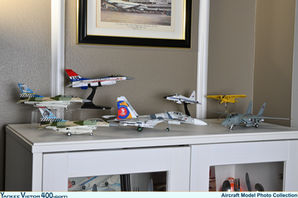Avensa & Servivensa Hybrids
- Jorge A. Zajia

- Dec 16, 2023
- 4 min read
Updated: Dec 30, 2024
Recently Aeroclassics re-released an ANA 727-281 in the Triton Blue livery. Despite being an appealing subject, it wasn't the typical instant sell-out Aeroclassics model, and shortly after its release, it was being offered with a substantial discount at a Black Friday sale. I took the opportunity to grab one with the intent of converting it into an Avensa example that wore the Triton Blue basic ANA livery with small company titles in the late eighties. The project also prompted me to dig out a GeminiJets Eastern DC-9-30 that I had purchased years ago with a similar intent in mind.

I want to share with you some of the historical background surrounding the aircraft these models represent.
Overview of Avensa and its relationship with the 727
Avensa got its first taste of the 727 in 1979 when Boeing managed to sell them two ntu -294 units originally destined for Syrian Arab Airlines. The airline developed an affinity for the type and quickly turned to the second-hand market looking for more of them. In the early 1980s Avensa leisurely added more 727s to its fleet, mainly older -100 series built during the sixties. But in the late 80s, a flurry of -200s showed up, and the airline's 727 fleet peaked at somewhere in between 15 and 20 active airframes around that time, making the type both, the flagship and workhorse of the company. During this time Avensa had a comprehensive route network connecting every corner of Venezuela, including many destinations that have never seen consistent and reliable air service again since the airline's decline, with neighboring countries in Northern South America, Central America, The Caribbean, as well as New York and Miami. The European destinations using DC-10 aircraft that gave the brand some global recognition came later during the airline's last years and were nothing more than an agonic gasp as by then Avensa was merely a shadow of what it once had been.

All Nippon Airways 727-281s that went to Avensa
Five of the several 727-200s that joined Avensa's fleet in the late eighties were -281s that had been retired by All Nippon Airways (ANA). At least three of them were seen wearing basic ANA c/s with Venezuelan registrations around the time they were being delivered to Avensa. At least two of them went into line operations still wearing basic ANA colors with small Avensa titles, one of which was YV-94C, the customized 727 featured in this article. Below is a table summarizing the ex-ANA Avensa 727s:
ANA reg. | Avensa Reg. | Remarks |
JA8345 | YV-92C | Coincidentally, JA8345 is the ANA aircraft represented by the donor model used for this project. Not seen wearing ANA basic c/s with Venezuelan/Avensa markings. |
JA8348 | YV-96C | Seen at MIA on Nov, 5 1987 wearing basic ANA Triton Blue colors with Venezuelan Reg. Apparently fully painted in Avensa billboard colors before entering operations. |
JA8350 | YV-93C | Not seen wearing ANA basic c/s with Venezuelan/Avensa markings. |
JA8351 | YV-94C | The customized model featured in this article. Seen in line operations wearing basic ANA Triton Blue colors with Venezuelan reg. as well as with small Avensa titles. |
JA8352 | YV-95C | Seen in line operations wearing basic ANA Mohican colors with small Avensa titles. |
The Model:



The real aircraft:


Eastern DC-9s and Servivensa
In the early nineties, as part of an aggressive cost-cutting campaign, the owners of Avensa created a sister airline called Servivensa. In short, the objective was to break Avensa labor unions by transferring the majority of the operations to the new, non-unionized, sister airline. As I recall, while they were effectively two separate airlines, from the passenger standpoint they were the same entity.
As Servivensa was being created in Venezuela, in the U.S. Eastern Airlines (along with a few other legendary airlines) was going bust. The Avensa group purchased several of Eastern DC-9-30s and -50s (I counted 9). Initially, the aircraft were split almost evenly between the sister airlines, but in the end, the majority of the ones that went to Avensa also ended up being transferred to Servivensa.
The majority of these DC-9s were put into service with both airlines while still wearing Eastern basic c/s, in many cases the faded silhouette of the Eastern titles and logos could still be recognized under the new operator's provisionary titles. This sort of perpetuated the Eastern Airlines' image in Venezuela, where the airline had been a regular visitor up until the end, for a few more years after its demise. Eventually, all of these airplanes received full Servivensa and Avensa color schemes.
The Model:



The Real Aircraft:

Fun fact: The donor model's original reg. was N8988E, which is also the reg. corresponding to the aircraft that became YV-760C in real life.

While I was too young to remember the Avensa 727s in basic ANA c/s, I do recall seeing the Avensa/Servivensa DC-9s wearing the Eastern colors, and even recall boarding one via stairs on what I believe was a CCS-MAR flight. They were a common sight in Venezuela during the 1992-1994 time frame and tend to bring good memories to those of us who remember them.
Below a mix of Avensa and Servivensa DC-9s on the domestic ramp at Maiquetía airport, showing many already painted in their new operators' full liveries. The two aircraft still wearing the Eastern basic c/s are Avensa YV-764C in the forefront (Avensa titles, but Servivensa reg.) and Servivensa YV-760C in the background.
Jorge A. Zajia








































Comments